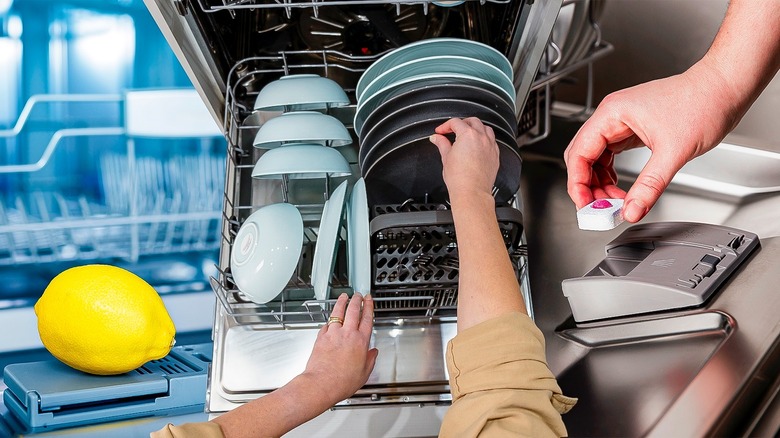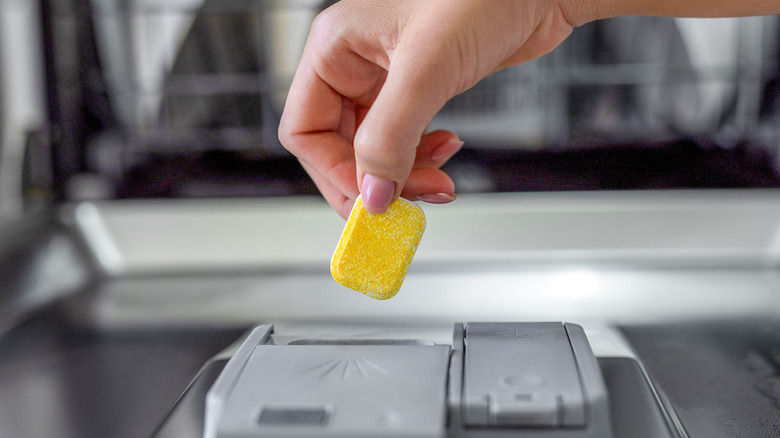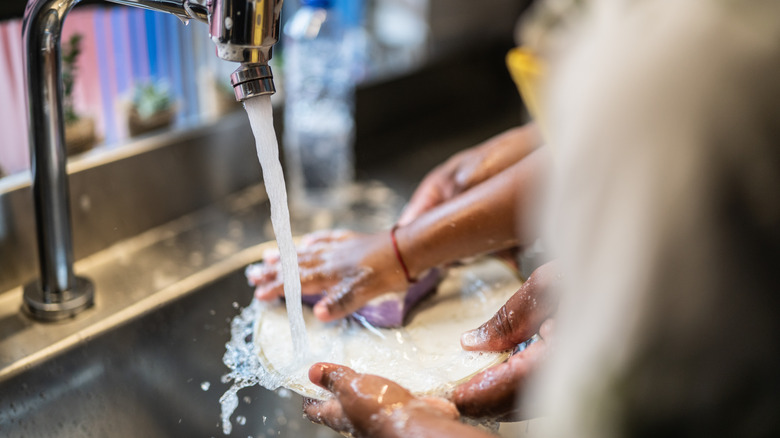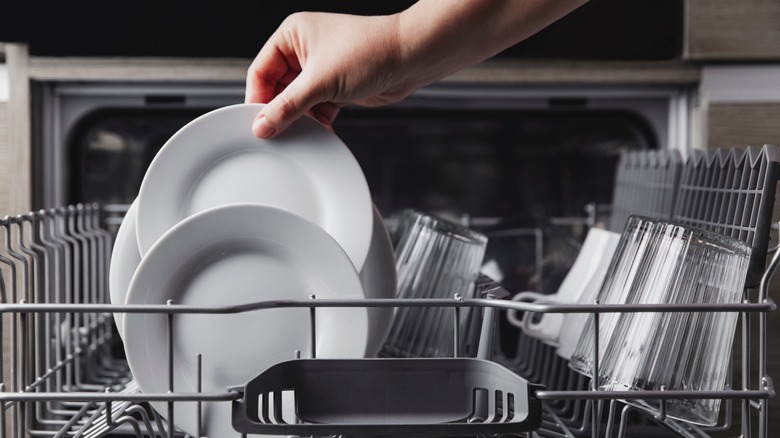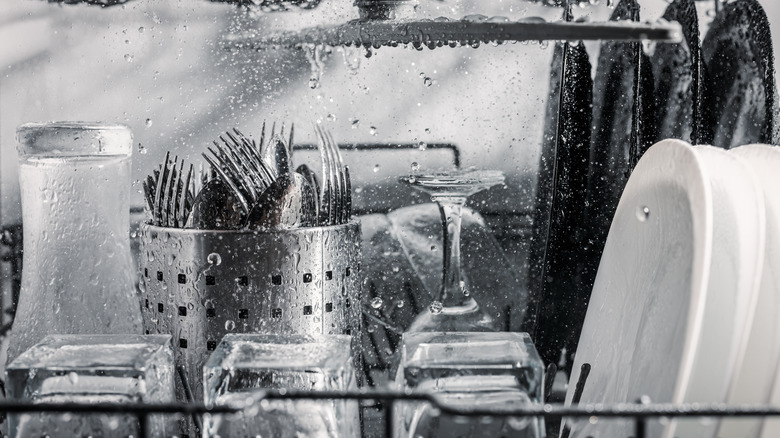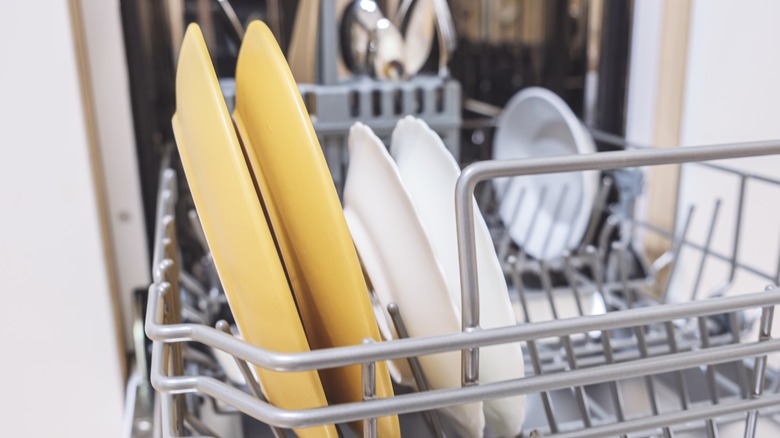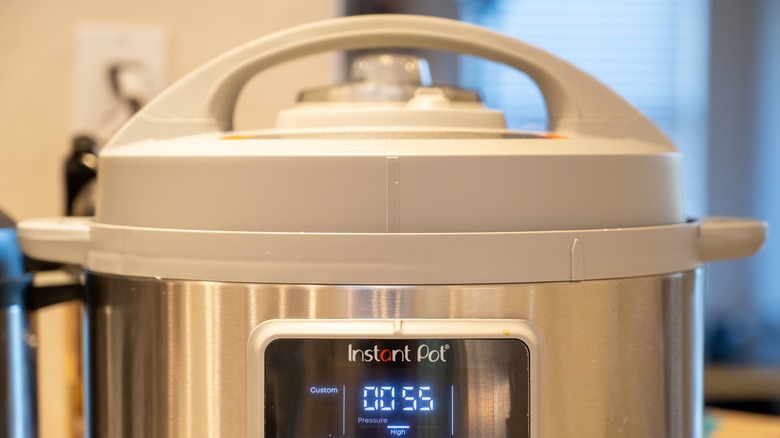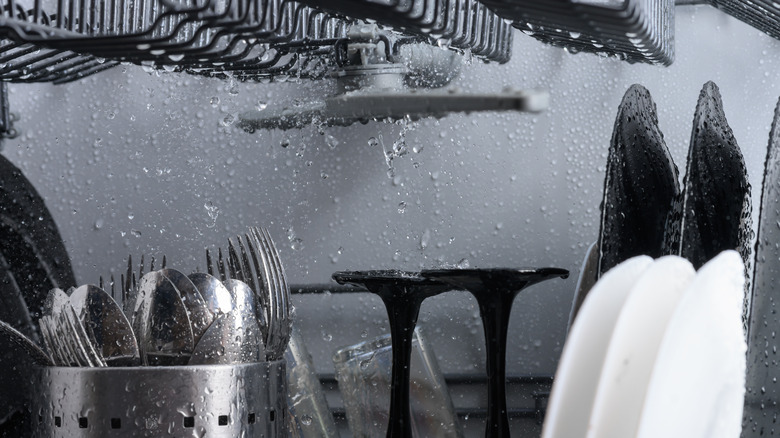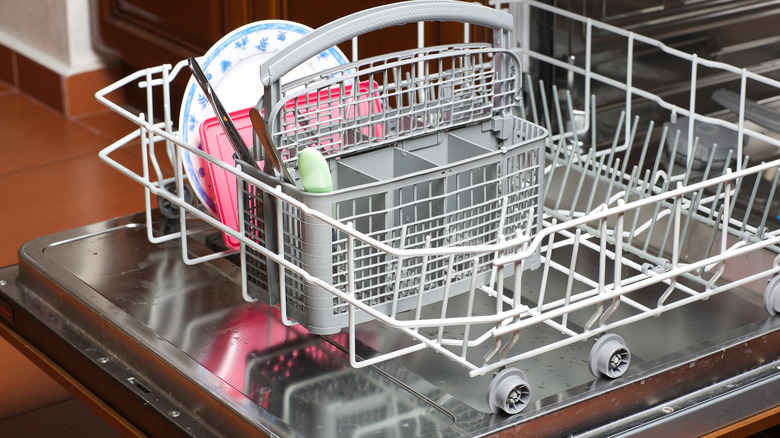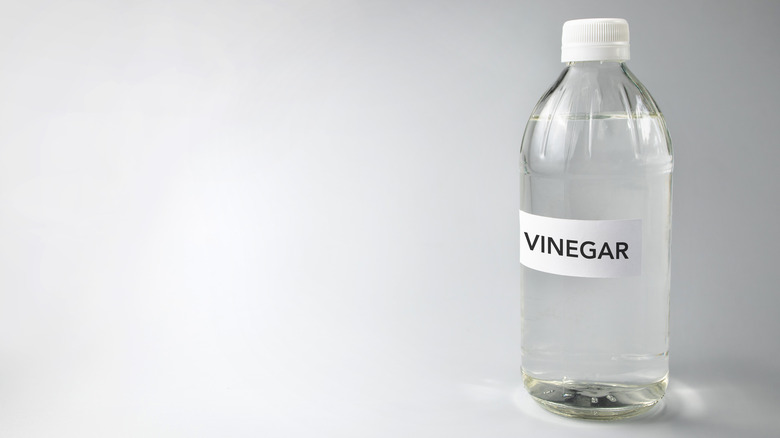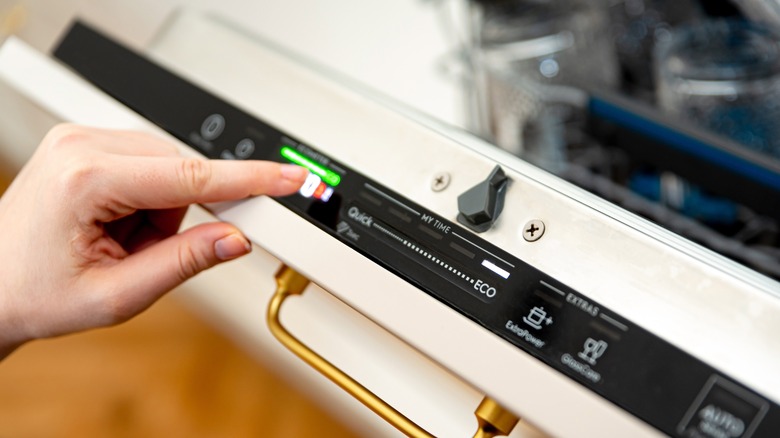13 Hacks That Will Make Dishwashing A Breeze
There have been many ingenious inventions in our never-ending pursuit to make kitchen life more convenient. From blending and juicing to microwaving and toasting, convenience is the cure for your kitchen woes. When it comes to appliances, dishwashers are one of the greatest time savers ever invented. The guttural hum of the wash cycle; the oddly refreshing steam that releases when you open the door; the mist slowly parting to reveal sparkling clean dishes; why toil over a sink of water when you can just use a dishwasher?
Dishwashers have been around since the mid-1800s. Although earlier iterations existed, a woman named Josephine Cochran is credited with inventing the modern dishwasher, which cleans using water pressure. Since then, dishwashers have become considerably more powerful than the manually operated OG's that preceded them. They're perfect for people with busy schedules and, more importantly, they don't leave you with shriveled fingertips.
That said, what dishwashers reduce in labor, hand washing makes up for in thoroughness. Getting the best results out of your machine requires more than simply popping your dishes in the washer and pressing start. Fortunately, we've put together a list of hacks that will make dishwashing easy and breezy.
Don't overuse dishwasher detergent
Contrary to popular belief, using more dish detergent does not necessarily equal a better cleaning job. Overusing it may leave behind clumps of wet detergent that can stick to dishware and clog the dishwasher drain. There's nothing worse than waiting hours for a cycle to complete only to find soapy grains everywhere. It defeats the entire time-saving purpose of a dishwasher. The amount of detergent that you use depends on the type of washer, the washing job, and the detergent variety. While it's recommended to follow the instructions of the washer manufacturer, following the designated amount that a brand suggests is perfectly fine, too.
If you happen to prefer single-dose pods, always use only one per load, unless otherwise instructed by the manufacturer. Make sure that your hands are dry before handling, moisture will make the pod sticky. One upside to using pods over detergent is that they're pre-measured. That means there's less of a chance of leftover residue. Pods work best for long wash cycles, yet don't always dissolve completely during shorter ones. Never use liquid dish soap. Unlike actual detergent and pods, liquid soap isn't made for washing machines. In fact, using them can potentially cause your dishwasher to overflow and make a sudsy mess.
Make sure to remove large food particles first
Sometimes it's easy to overlook the most obvious things. How often have you ignored the load limit that's clearly displayed on detergent scoopers, only to open your washer and find powdery remnants? This next hack is equally the most "duh," and important step to making dishwashing a breeze. Before loading your dishwasher, always make sure to clean off large pieces of food first. Skipping a quick rinse will not only result in an incomplete cleaning job, but particles of food can contaminate other dishes, dirty the interior, and clog up your drain. Trust us, having to dislodge tiny specks of ingredients and mop up a puddle of water is not worth the extra hassle.
Hopefully, you rinse your dirty dishes before placing them in the sink, but if you forget, a simple scrape with a spatula or soak should easily loosen the dried debris. For foods with a glue-like grip, try adding some dish detergent and letting them soak in warm water for 15 to 30 minutes. Dish detergents contain several enzymes created to specifically break down food by digesting protein and starch.
Rinse plastics before putting them in the dishwasher
While dishwashers are versatile machines that can clean a variety of materials, some dishware requires more work than others. For example, washers can sometimes leave plastic dishware damp with spots and streaks. Plastics are harder to dry because they are made with material that is less dense than glass, metals, and wood. The conductivity of materials determines how they respond to heat — water evaporates more efficiently from dense materials because they absorb more heat. The temperature inside of a dishwasher can range between 130 F and 170 F, which is considerably hot.
Plastics don't dry as well because they are light and thin. That prevents them from absorbing enough heat to evaporate water droplets, which is how you get spots and streaks. The heat that dishwashers produce isn't only for drying either, it also helps kill germs. Besides material type, other causes of spots and streaks could be the detergent you use, low water temperature, or the hardness of your water. Another way to reduce spots and streaks is by leaving space between your dishes when you load them. It will allow more air to flow through and dry better.
Load utensils handle side-up to avoid bacteria
The debate over how to properly load utensils into a dishwasher is a nail-biter. There are more steps than simply tossing them in and pressing start. Whether you're a Type A personality that loads Tetris-style, or a freeform cleaner that goes against the grain, following this dishwasher hack will give you a pristine clean. When loading your dishes into the washer, many professional chefs and appliance manufacturers recommend that you point your utensils handle-side up.
Not only is it safer, but handle-side down also helps lower the chance of passing bacteria from your hands to the utensils, which will leave you with additional cleaning. It's especially suggested for knives and other sharp utensils, which can potentially injure you. If it's a thin object, make sure to angle it so that it doesn't slip through the rack and interfere with the dishwasher arm. Spoons are different due to their width, which can take up space in the rack. However, if you're only washing a few utensils, you can place them handle-side up as well. Make sure not to overcrowd the baskets, utensils need space in order to be cleaned thoroughly.
Angle dishes on the bottom rack for best clean
There is a science behind loading dishwashers. From the direction in which water sprays to the positioning of different dishes, several things must be taken into consideration. With a limited amount of space to use, a dishwasher can often feel like a cleaning Rubix cube. It's an ingenious invention that's made to make your job easier but can easily leave you with more work to do. While some prefer to hand wash pots and pans, dishwashers are more than capable cleaners. When positioning pans in the dishwasher, always use the bottom rack and sit them at an angle. Angling helps the water jets make contact, which cleans them better.
Knowing how dishwashers work helps as well. When in use, water fills the basin beneath the bottom rack. The dishwasher releases the detergent into the basin and heats up the water. A rotating jet then sucks and shoots the water onto your dirty dishes. Water pressure has less of an effect on dishes that are positioned vertically, whereas angling provides more pressure for cleaning. Never lay dishes flat or overcrowd them, it's important that you leave space so the water jets can spray evenly.
Try the dish rack hack for a better clean
When you do a deep dive into the art of cleaning, you'll come across all sorts of clever hacks. Thanks to dishwashers, long gone are the days when pulling straws decided who got stuck with dish duty. That said, these imperfect machines are far from magical. Plastic dishware in particular is susceptible to stains, warpage, and potential ruin if loaded incorrectly. Most plastic dishes and utensils are lightweight and can't withstand the pressure from water jets. Water jets are powerful enough to eject plastic dishware from the rack. A dish may land in a position that prevents water from hitting the areas that require cleaning. Fortunately, there's a dishwasher hack that will protect your plasticware.
Next time you have plastics to wash, use your dish rack to secure them in the washer. Forehead smacking-simple, all you need to do is take your empty dish rack, flip it upside down, and place it on top of the dishes you have loaded on the bottom rack. The weight fastens them in place, while the wire frame allows water to still flow freely. With this clever hack, you no longer need to worry about your plasticware being jostled around.
Disassemble your Instant Pot lid before cleaning
As versatile as dishwashers are, they can easily damage certain types of cookware. Take Instant Pots, for example. They're constructed of several parts: the lid, sealing ring, pressure cooking pot, and the housing, which contains electrical components. The lid, sealing ring, and pressure cooker are the only dishwasher-safe parts. The lid itself is also composed of three parts — the anti-block shield, float valve, and pressure-release knob — that must be disassembled to be cleaned thoroughly. Suffice to say, it's a bit more complex than washing a regular pot.
The anti-block shield prevents food particles from blocking the release of steam while the float valve helps secure the pressure. While the pressure-release knob is pretty self-explanatory, it's important to note that not all models allow you to remove it. Those that allow you to separate each part can be cleaned more thoroughly. It may add a few more minutes to your cleaning process, but you'll avoid having to hand wash away food remnants. And, it's overall just a more hygienic way to cook food with your Instant Pot.
Remove tarnish from utensils with aluminum foil
There's nothing like owning a quality flatware set, but without proper maintenance, the shiny silver luster will slowly fade. When silver fades it's called tarnishing. It's a chemical reaction between sulfur-containing gasses in the air and metal, which causes discoloration. There are many ways to remove and prevent tarnish, and interestingly enough, using your dishwasher is one of them. With the help of aluminum foil, you're going to perform a fun science experiment.
The clever hack comes courtesy of the always-reliable TikTok where user Carolina McCauley demonstrated how a ball of aluminum foil can remove tarnish. Take a single sheet of foil, ball it up, and place it inside your dishwasher's utensil rack. Make sure to leave space in the basket for the ball to reach the bottom. Depending on your utensil basket type, you may need to use more than one aluminum ball. Secure it with the basket lid and start the washing cycle. As the water pressure pushes the ball around, it will brush against the flatware and remove the tarnish.
Although the video leaves you hanging on the explanation of why when aluminum comes into contact with the sulfur on the flatware, it causes a chemical reaction that transfers the sulfur to the aluminum. The sulfur is naturally attracted to both metals but has a stronger reaction to aluminum. In fact, it actually causes a tiny electric current to zap between the two.
Clean the spray arm during routine maintenance
With so many benefits to owning a dishwasher, there's bound to be a catch. To ensure that your dishwasher continues to work like a breeze, you'll need to maintain it properly. It may seem counterintuitive that a washing machine requires cleaning, but like any kitchen tool, dirt builds up over time. That can affect the cleaning process, clog the drain, and even worse, attract bacteria. The interior and dish racks are just two of several parts to maintain. One overlooked but highly important dishwasher task is routinely cleaning the spray arm.
The spray arm is responsible for delivering pressurized water and detergent to your dirty dishes. Depending on the brand, your washer can have up to three rotating spray arms. When the tiny holes get clogged up with food particles, it prevents water from releasing, which of course, is the whole point. The spray arm should be checked at least once a month. Cleaning it is easy, simply wipe it with a damp cloth. Every six months, you can give it a deeper clean by removing it and soaking it in soapy water with vinegar, then using a toothpick or toothbrush to get into the crevices.
Use a lemon to reduce limescale build-up
Despite their cleaning abilities, dishwashers can easily become a germ party. The last thing you want is bacteria dancing around inside your dishwasher. Some tell-tell signs that it's time for cleaning are cloudy and partially washed dishes, an undesirable odor, and water blockage. Along with those, you'll also have to watch out for limescale build-up. Limescale builds up naturally as your washer is exposed to water with a high amount of calcium — it's also known as "hard water." If you see solid white clumps or grayish residue layered along the interior of your dishwasher, that's limescale.
Fortunately, there is a way to remove and even avoid limescale altogether: Lemons. As surprising as it sounds, like all citrus fruits, lemons contain the natural compound citric acid. Citric acid is a common ingredient in household products because it's actually pretty great at breaking down dirt and limescale. Despite their citrusy names, limescale is totally unrelated to lemons. It'll also leave your dishwasher with a refreshingly pleasant aroma.
Run a cycle with vinegar to clean your dishwasher
The churn of a well-maintained dishwasher is like sweet music to the ears of people who appreciate a clean kitchen. In addition to hand washing each part and crevice, another way to prevent your dishwasher from becoming unsanitary is with vinegar. Vinegar is made from acetic acid, a powerful colorless organic compound that can dissolve dirt, grease, and grime, and kill bacteria. When using it to clean your dishwasher, we recommend using distilled white vinegar because it doesn't include a coloring agent, which can leave stains.
Only four easy steps are required. First, fill a dishwasher-safe container with white vinegar — a glass bowl or beaker also works. Set the container on the top rack and make sure it's balanced and secure. Before you begin, deactivate the drying cycle, then run a single cycle without soap on the highest temperature setting. The vinegar will help loosen tiny food particles and cleanse the interior of foul smells. After it finishes, open your dishwasher and let it air dry.
Use Tang as an alternative to dish detergent
Necessity can sometimes breed the cleverest hacks. Another surprisingly effective way to clean your washer is with Tang. Yep, we're talking about the iconic orange-flavored powdered drink mix that's been making kids bounce off the walls since the '50s. Now, before you say "Yeah right," and continue scrolling, just wait until you find out how it works. Using Tang as a cleaner actually makes a lot of sense. Like lemons and other citrus fruits, it contains citric acid. As previously mentioned, citric acid and mucky build-up don't get along well. When in contact, the acidity creates a chemical reaction that breaks down dirt and food particles.
Tang is not only an impressive cleaner, it leaves the interior smelling citrusy and fresh. Unlike many commercial products, it's biodegradable and non-toxic, too, which means that it's eco-friendly. To use it, empty your dishwasher and start a hot water cycle. Let it run for a few minutes to soften any remaining food debris, then after about seven minutes, pause the cycle and add 12 ounces of Tang powder into the detergent cup. You can also sprinkle a bit around the bottom of the interior as well. Restart the cycle and once it finishes, allow it to air dry. We recommend cleaning out your washer once a month.
Press air dry to extend your dishwasher's life
Beyond being amazing time-savers in the kitchen, dishwashers are pretty pricey. That's why it's important to properly maintain yours in order to ensure it keeps cleaning for years to come. From how often you sanitize the interior to the attention you give to each individual part, there are many boxes to check off. Even the settings that you choose can impact the life of your dishwasher. That said, things tend to get really hot inside during cycles. According to Maytag, the average temperature of a hot water cycle can range between 120 F to 145 F and can increase to 155 F during the final rinse.
That means that every time you use your dishwasher, you're heating up its electrical components, which require using the washer's fans to be cooled down. Using it over time will wear away at the electrical components, thereby reducing the machine's lifespan. Instead, we suggest air drying because it puts less strain on the electric heating parts. While it does take longer to dry, it also saves energy. Only use the final rinse for really grimy jobs, other than that, air dry is the one dishwasher setting you should start using.
